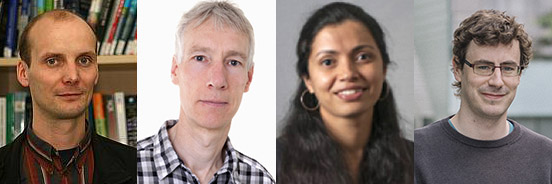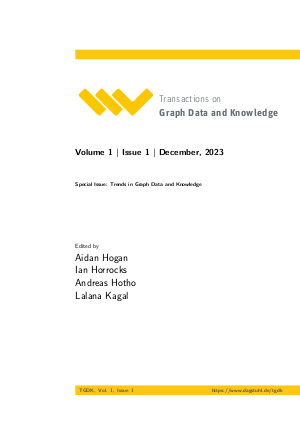Transactions on Graph Data and Knowledge: la nueva revista «Diamond OA» creada por Aidan Hogan con un equipo internacional
Abril, 2024.- Transactions on Graph Data and Knowledge (TGDK) es una nueva revista que publica investigaciones revisadas por pares (peer review) sobre el uso de grafos para representar datos y conocimientos, así como las técnicas, teorías, aplicaciones y resultados que surgen en este entorno.
Creada por Aidan Hogan, Universidad de Chile; Ian Horrocks, University of Oxford, U.K.; Lalana Kagal, Massachusetts Institute of Technology, U.S. y Andreas Hotho, University of Würzburg, Alemania; TGDK es una revista Diamond OA, esto quiere decir que los artículos se publican abiertamente sin costo, tanto para las y los autores, como también para lectores.

Esta iniciativa surge como una alternativa que busca cambiar el esquema de negocios de muchas revistas y editoriales que, actualmente, están haciendo un cobro sobredimensionado para publicar investigaciones académicas. “La brecha del servicio que proveen editoriales como Elsevier y el costo que imponen es abismante”, explica Aidan Hogan, sub director del Departamento de Ciencias de la Computación de la Universidad de Chile, e investigador IMFD. “Los servicios son en gran parte provistos por académicos/as que escriben, editan y revisan los artículos de forma voluntaria. Los editoriales obtienen pagos de las suscripciones para poder leer los artículos o en los APCs (cargos de procesamiento de artículos) que cobran para publicar artículos de forma Open Access con ellos”, añade.
“Andreas, Ian y Lalana renunciaron a sus cargos como editores en jefe de la revista «Journal of Web Semantics» del editorial Elsevier, y en paralelo, yo escribí una publicación de blog que detalla los problemas con Elsevier y las editoriales parecidas, por la cual fui invitado por unl comité de SWSA a participar en la definición de esta nueva revista, y a ser uno de sus editores en jefe”, destaca Hogan.
¿Qué es la publicación científica?
La tradición académica de las editoriales y revistas científicas es de larga data. Para las personas que trabajan en ciencias, el proceso de publicación es conocido: se envía la investigación a una revista (las cuales pueden tener más o menos prestigio), allí es evaluada, corregida y publicada. Esto permite que el trabajo sea, de alguna forma, validado por la comunidad científica internacional, y que pueda estar disponible para personas que trabajan en la misma área.
Hasta hace algunos años, los costos asociados eran la diagramación, impresión y distribución; ya que como explica Hogan, las revisiones siempre han sido realizadas por pares investigadores, peer review, que no reciben remuneración por parte de las revistas. Sin embargo, muchas editoriales y revistas están hoy haciendo cobros que superan con creces los costos de publicación, la que actualmente se realiza principalmente en la web, por lo que los costos de impresión y distribución son inexistentes, y el de diagramación, mucho menor que antes ya que los mismos investigadores/as pueden realizarlo sin problemas.
El cobro por el acceso al conocimiento
El equipo tras TGDK, y muchos otros científicos/as, consideran que las editoriales se están aprovechando de la tradición académica, como también de las instituciones que la respaldan, para obtener ganancias de los contribuyentes de los países que financian la investigación.
“Vemos que, con la web, hay formas de publicar nuestras investigaciones de forma mucho más económica, y así, ayudar a reparar esta situación. Pensando en Chile, puedo ver como los costos exorbitantes pueden excluir a algunos países o investigadores de participar en el sistema, profundizando la desigualdad que hay en la participación en el desarrollo de la investigación y en el acceso a sus resultados”, señala el investigador, quien también destaca la importancia del acceso libre y gratuito al conocimiento, recordando “la historia de Aaron Swartz, quien intentó reparar esta desigualdad, liberar los resultados de investigación financiada por las personas a la humanidad, y murió a una edad temprana como consecuencia de sus convicciones”.
El objetivo de TGDK es ser un ejemplar de un nuevo tipo de revista de investigación, que mantiene o supera el prestigio y la calidad de las revistas internacionales publicadas con editoriales comerciales, pero sin los costos elevados e innecesarios asociados. “La tradición académica dificulta ese proceso, pues en muchas instituciones se valoran las publicaciones por la editorial del artículo, su inclusión en índices internacionales, y su ‘factor de impacto’ que mide cuántas citas reciben los artículos de la revista, todos elementos que son controlados, en gran parte, por empresas lucrativas”, señala Hogan. Para el investigador, no participar en este sistema es casi incompatible con ser académico, por lo que es necesario cambiar este entorno para promover la investigación científica sin desigualdades.
Un cambio necesario
Para promover la nueva revista TGDK, los y las investigadoras crearon una comunidad de expertos internacionales, como editores y revisores, que prestan su reputación a la publicación. La editorial que la publica, Dagstuhl Publishing, ofrece servicios a bajo costo y lo más importante, comparte plenamente la visión del equipo tras la publicación.
Ya está publicada una primera edición con doce artículos seleccionados, y a mediano plazo, el equipo busca la inclusión de TGDK en índices internacionales de mayor relevancia, para que adquiera un buen factor de impacto. “Estamos implementando algunas innovaciones sobre los tiempos de revisión, reconocimientos para revisores anónimos, publicación de recursos más allá de la investigación, entre otros. Quedan muchas cosas por mejorar en la noción actual de una revista académica más allá de su costo”, destaca Hogan.
A la vanguardia en grafos
Transactions on Graph Data and Knowledge (TGDK) es una nueva revista de acceso abierto, que publica contribuciones de investigación sobre el uso de abstracciones basadas en grafos para representar datos y conocimientos.
Los grafos permiten aplicar una amplia variedad de técnicas para integrar, consultar, razonar y aprender a partir de datos y conocimientos diversos a gran escala. TGDK reúne los conocimientos de diversas comunidades de investigación en informática, en bases de datos de grafos, aprendizaje de representación de grafos, teoría de grafos, grafos de conocimiento, representación del conocimiento y web semántica.
En los últimos años ha resurgido el interés por el uso de grafos para representar datos y conocimientos. El tema está ganando adeptos tanto en la industria como en el mundo académico, y los avances en otras áreas de la informática se reflejan también en este campo: por ejemplo, los avances clave en el área del aprendizaje profundo han dado lugar a la aparición de nuevas y potentes técnicas en el ámbito del aprendizaje de representación de grafos.
Los datos y el conocimiento de grafos también pueden desempeñar un papel en otras áreas de la informática, dando lugar a avances en la ciencia de datos, la recuperación de información, el procesamiento del lenguaje natural y otros campos. Por esta versatilidad, siguen apareciendo cada vez más usos de los grafos de datos, facilitando nuevos descubrimientos en disciplinas científicas, más transparencia en la gobernanza, aplicaciones más inteligentes para los usuarios, una mejor gestión de los datos en las industrias y muchos otros avances. TGDK apunta a mostrar los avances del estado del arte de esta área y cambiar el entorno de las publicaciones académicas.

